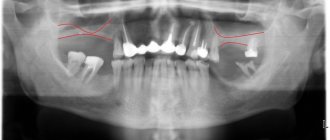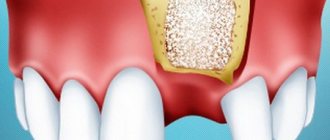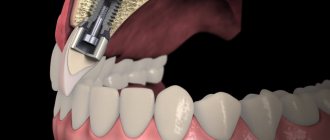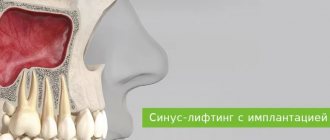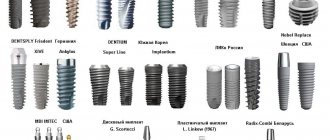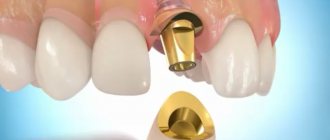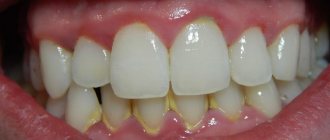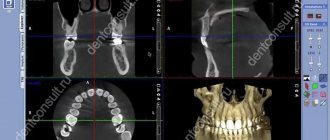Open (lateral) sinus lift (direct subantral augmentation) is a procedure to increase the thickness of the bone tissue of the upper jaw by raising the bottom of the maxillary sinus and introducing osteoplastic material into the space under its mucous membrane.
The operation is performed through a lateral “window” in the wall of the upper jaw.
What is a sinus lift?
Sinus lifting (sinus floor elevation) is a procedure for increasing bone tissue in the area of the maxillary sinuses. They are located on the upper jaw to the left and right of the nose. In most people, the roots of the chewing teeth of the upper jaw are initially located in the maxillary sinuses, so after the removal of these teeth there is not enough bone tissue to install an implant. Closest to the maxillary sinuses are the molars (sixth and seventh teeth), less often the premolars (fourth and fifth teeth), and sometimes the canines.
The orthopantomogram shows the boundaries of the bottom of the maxillary sinuses and the apex of the alveolar ridge. There is not enough bone tissue to install implants.
Sinusitis
Speaking about complications after sinus lift
, the symptoms of sinusitis are considered leading. The doctor may damage the Schneiderian membrane. It is located in the area of the maxillary sinuses. This is possible if the dentist uses hand instruments instead of an ultrasonic device. An infection gets into the upper jaw, causing sinusitis or sinusitis. Exacerbation of sinusitis is a contraindication to sinus lift. The disease must first be cured. Usually the doctor prescribes a 2-week course of antibiotic therapy.
Indications
To install an implant, a minimum of 10 mm of bone tissue is required to the maxillary sinus. Otherwise, a rise in its bottom is shown.
1) If the distance to the sinus is 8-10 mm, it is possible to perform a closed sinus lift with simultaneous installation of implants. The term “closed” means that no additional incisions are required. This can be compared to endoscopic operations. The postoperative period is easier.
2) If there is bone tissue from 5 mm to 8 mm, an open sinus lift (classic version) is performed with simultaneous installation of implants. This technique creates access to the maxillary sinus from the cheek. Its mucous membrane is peeled off, lifted, and bone-substituting material is placed in the resulting space, which is absorbed and replaced with its own bone.
3) If the distance to the maxillary sinus is less than 5 mm, an open sinus lift is performed without installing implants. For immediate installation of implants, a sufficient volume of bone tissue is required in which they will be stabilized. If it is not enough, then the bone volume is first increased. After 6-9 months, implants are installed. After another 6 months, crowns are installed on the implants. With severe atrophy of bone tissue in the upper jaw, the treatment period can be more than a year.
Common Complications
Insufficient preparation for a sinus lift can cause many adverse outcomes. This means both preparation on the part of the patient and planning of the operation by the dentist. In addition, complications can be caused by medical errors during surgery or insufficient compliance with the regimen and recommendations during postoperative rehabilitation.
If a sinus lift is performed, the following conditions may develop:
- Bleeding from the operated area. The problem is caused by insufficient examination of the patient, during which blood clotting pathology was not identified, as well as pressure surges. To relieve the condition, hemostatic drugs of local and systemic action are used. In our clinic, the anesthesiologist carefully and delicately adjusts the blood pressure numbers during the operation and postoperative period.
- Wound infection. By refusing to take antibiotics, the patient risks the success of the operation, and immunodeficiency and poor personal oral hygiene cause the proliferation of pathogenic microorganisms and the inflammatory process. A person is worried about: increasing pain, progressive swelling, increased temperature, bad breath, discharge from the operated area. If you have these symptoms, you should immediately contact your dentist. In our clinic, the patient is given a postoperative case with medications and instructions for use, which eliminates problems.
- Seams coming apart. The problem may be due to poor application or improper cleansing of the wound during the rehabilitation period, that is, mechanical damage. Most often in patients who tear off stitches with a toothbrush.
- Perforation of the maxillary sinus. When treated in specialized clinics by an experienced doctor, this is impossible in principle . Modern methods of sinus lifting, as well as preliminary clear planning of surgical intervention, make it possible to avoid this complication. Some perforations are so minor that they do not require any action, while in other situations the operation must be stopped.
Sinus lifting may involve the simultaneous installation of implants, which can also be accompanied by a number of adverse outcomes. Most often, problems arise with fixing an artificial root: when the doctor overestimates his own capabilities and the capabilities of the bone tissue, the implant is placed in weak areas of the bone, then it can become loose, fall inward, or fall out along with part of the bone tissue. The surgeon must first assess the risk of complications and give preference to two-stage treatment if there is a detected area of compromised bone.
Contraindications
In addition to general contraindications (type 1 diabetes, recent radiation therapy, etc.), there are a number of factors that may carry additional risks for the operation. The most common limitation is inflammatory diseases in the maxillary sinus area. It is necessary to identify the source of inflammation. Additional consultation with an ENT specialist may be required. Some difficulties may be due to previous operations in the area of the maxillary sinuses.
Rehabilitation after surgery
Many are afraid of this operation due to fear of pain, or fear of damage to the maxillary sinuses, but the main thing here is to choose a good doctor. This must be an experienced and qualified specialist in maxillofacial surgery. In this case, the likelihood of any complications is minimized.
The likelihood of an unfavorable outcome of the operation is influenced by:
- elderly age,
- smoking,
- low immunity,
- pathologies that suppress the ability of tissues to regenerate,
- caries and inflammatory diseases in the oral cavity,
- pathologies associated with blood clotting disorders.
These risks can be eliminated (or minimized) by high-quality and complete diagnostics and the development of a surgical plan in strict accordance with the individual characteristics and condition of the patient. Absolute contraindications for sinus lifting are inflammatory diseases of the nasopharynx and paranasal sinuses (sinusitis, sinusitis, chronic rhinitis), the occurrence of tumors on the mucous membrane (polyps), and the presence of partitions in the sinuses.
Full recovery after a sinus lift takes on average 4 to 6 months. After this period, implantation can be done, but the most critical period is 8-10 days from the date of surgery. During this time, it is necessary to extremely limit physical activity, treat sutures, take only liquid or semi-liquid and soft food that does not require intensive chewing, as well as medications according to the regimen prescribed by the doctor.
Unpleasant sensations (pain, swelling, a feeling of heaviness or discomfort) occur immediately as the anesthesia wears off, and can continue, gradually subsiding, for up to a month. Most often, the swelling subsides during the first two weeks, the sutures are removed no later than after 14 days, and the pain goes away during the first week.
Open
The first step is to numb the surgical site. Local anesthesia, as for dental treatment. The procedure itself is painless.
At the second stage, an incision is made in the gum in the area of the missing teeth. The gum itself moves upward, exposing the underlying bone tissue. Then access to the maxillary sinus is created. With the help of special instruments, the wall of the maxillary sinus is thinned, limiting it from the oral cavity. The inside is lined with mucous membrane (Schneiderian membrane). During surgery, the mucous membrane peels off and rises.
Bone replacement material is placed in the resulting space, which eventually dissolves and is replaced by its own bone.
Despite the apparent complexity of the procedure, open sinus lift has several advantages. It is possible to significantly increase the volume of bone in the maxillary sinus area, even in cases where the distance to it is only 1 mm. The operation is performed under direct vision control, so the implant surgeon can take into account all anatomically complex areas and avoid complications, for example, rupture of the mucous membrane of the maxillary sinus.
Open sinus lift with immediate installation of implants.
Stages of lateral sinus lift
- Anesthesia. The operation is performed using local anesthesia, sometimes sedation is additionally used - putting the patient into a state of half-sleep with the help of medications. Sedation is indicated for fear of dental procedures; its use allows the patient to relax emotionally and physically, and the doctor creates a comfortable working environment. An important feature of sedation is that the patient is conscious and able to respond to the surgeon’s requests and instructions.
- An incision in the oral mucosa and peeling it off from the bone on the outer surface of the jaw in the projection of the maxillary sinus.
- Providing access to the maxillary cavity: creating a “window” using a surgical drill or an ultrasonic surgical system. After removal of the bone fragment, Schneiderian membrane becomes visible.
- Peeling of the mucous membrane from the inner walls of the maxillary sinus using sinus lift curettes.
- Raising the bottom of the maxillary sinus. The height of the lift is determined by the length of future implants.
- Filling the subantral space with osteoplastic material.
- Closing the “window” with a bone fragment obtained earlier.
- Suturing the oral mucosa.
After surgery, antibiotics and mouth rinsing with antiseptic solutions are required.
The installation of implants begins 3-4 months after surgery to increase the volume of bone tissue.
The doctor may decide to perform immediate implantation - installing implants simultaneously with a sinus lift. This becomes possible only if there is sufficient bone thickness to initially stabilize the implant - at least 3-4 mm. In this case, they talk about a one-stage open sinus lift.
Sometimes a sinus lift is combined with tooth extraction. The condition for this type of intervention is the absence of acute inflammatory processes in the root zone of the tooth. After tooth extraction and elevation of the sinus floor, immediate implantation is desirable: this will allow for rapid aesthetic and functional effects.
3-4 months after installation of the implants, prosthetics can begin.
Closed
Unlike the open one, the closed version is carried out only simultaneously with the installation of implants. The gum incision is the same as for conventional implantation.
First, preparations are made for implant installation. A bed for the implant is formed. Then a special instrument is installed through it, it is called an osteot, with the help of which the bottom of the maxillary sinus is raised. After raising the bottom, the implant is installed.
The advantages of this method are the minimal invasiveness of the procedure and an easier rehabilitation period. However, in this case it is possible to raise the bottom of the sinus only by 2-3 mm. If you try to perform a closed sinus lift with a fundus elevation of 4-5 mm, there is a risk of rupture of the mucous membrane of the Schneiderian membrane.
First, a bed is formed for installing the implant. Through it, the bottom of the maxillary sinus is raised. The procedure involves one-stage installation of implants.
What complications are there?
Among all the numerous possible options for an unfavorable outcome of the operation, we can distinguish specific complications (for example, perforation of the maxillary sinus) - characteristic specifically for sinus lift, and nonspecific (for example, bleeding) - those that sometimes occur after any surgical intervention.
It should be noted that symptoms such as pain, swelling and slight bleeding are not complications after sinus lift, but are caused by the body’s natural reaction to surgical intervention. They are inevitably present in the first few days after surgery and gradually subside.
If symptoms such as
- bleeding,
- incessant pain
- heat,
- nasal congestion and difficulty breathing,
this may indicate the onset of a complication and requires immediate consultation with a doctor.
Edema
Swelling is a common consequence of incisions and other tissue damage during surgery. Normally, swelling occurs immediately after surgery and subsides within 3 days. If swelling does not disappear after sinus lift, this is an alarming symptom in which you should definitely consult a doctor.
Pain
The question of how long it hurts after a sinus lift bothers many. In general, it is normal to experience pain after surgery as the anesthesia wears off. The reason why it hurts after sinus lift surgery is the physiological response of the body to microdamage to tissue and is a necessary element of the recovery process.
The pain is usually minor, but if it bothers you, you can take a pain reliever prescribed by your doctor. Normally, pain after a sinus lift gradually weakens and goes away within a week. The perception of pain is different for everyone, it is very individual, but in any case, a normally healing wound hurts less and less. If the pain does not subside, or even worsens, this means that you need to call a doctor.
Bleeding
On the one hand, bleeding is a natural and inevitable consequence of traumatic damage to small vessels during surgery. On the other hand, any bleeding is a potentially life-threatening situation. Of course, in the operating room there are all the means and capabilities to instantly stop bleeding, so the operation itself is often almost bloodless, especially if it is an operation such as a closed sinus lift, which is often combined with implantation.
There should be no bleeding from the nose after a sinus lift, but after the operation (mainly during the first two days), a small amount of blood or ichor may be released from the operation area in the mouth or from the nose. Therefore, to prevent such conditions or in case of minor bleeding immediately after the end of the operation, it is recommended to apply a cold compress to the cheek on the side where the operation was performed. And also bite a sterile swab or napkin at the operation site. The cold compress should not be kept for longer than 15-20 minutes and you should also wait 15-30 minutes before applying the compress again. If the bleeding does not stop, you should consult a doctor.
Infection
Infection can get into a surgical wound in several ways:
- violation of aseptic and antiseptic requirements during surgery (for example, a doctor may accidentally touch an area of mucous membrane with an instrument and not notice it, or a drop of saliva may accidentally enter the wound),
- refusal to take medications prescribed by a doctor during the postoperative period (including unintentional, for example, skipping the time of taking an antibacterial drug),
- the presence of sluggish untreated infections in the oral cavity or nasopharynx,
- entry of infection or bone material into the cavity of the maxillary sinus due to perforation of the mucosa,
- violation of oral hygiene during the rehabilitation period,
- wound injury and suture dehiscence,
- a serious decrease in immunity due to hypothermia, active sports, hard work or emotional stress.
The action of pathogenic microorganisms that penetrate the wound causes the development of inflammation. A sign of this is increased pain, increased swelling, increased redness of the tissue at the operation site, and the appearance of purulent discharge. Often there is also an increase in temperature (up to 38 degrees and above). In the future, the development of infection can lead to rejection of the implanted materials, serious illnesses (sinusitis) and other unpleasant consequences, so you cannot delay visiting a doctor if such symptoms appear.
Sinusitis
Inflammation of the paranasal sinuses (including the maxillary sinuses - sinusitis) occurs due to the penetration of a bacterial infection into the mucous membranes of the sinuses and can be either a consequence of infection of the damaged mucosa or a complication after a runny nose.
After a sinus lift, it will be better to make every effort not to catch a cold or illness, or to catch a respiratory infection, since this will not only create additional problems for the healing of sutures and tissue damage at the operation site (swelling, deterioration of ventilation of the nasal passages and sinuses, accumulation of mucus, coughing and sneezing, etc.), but will also weaken the immune system, slow down the engraftment of osteogenic material and recovery after surgery.
Sinusitis
Sinusitis is a type of sinusitis, inflammation of the maxillary sinuses, precisely those located at the site of the operation. As a complication after sinus lift, this disease can only occur if during the operation the sinus mucosa, the Schneiderian membrane, was damaged (for example, torn or punctured). Damage to it can lead to infection and the development of inflammation. Sinusitis not only can negate the whole point of the operation, but is also a dangerous disease in itself due to the proximity of the maxillary sinuses to the brain, and therefore requires serious and immediate treatment.
If the patient has sinusitis (which developed before surgery), it is impossible to perform a sinus lift. First, you need to undergo a course of antibacterial therapy, and only after that plan a sinus lift surgery.
Headache
This symptom may appear as a result of nerve irritation due to traumatic damage to the jaw tissue, or due to the toxic effects of infectious agents. It may occur due to developing sinusitis or other inflammatory reactions.
Headache can also occur due to emotional stress, when the patient is very afraid of the operation or fears complications. Pain can also be triggered by a surge in blood pressure, which often occurs after surgery in people prone to hypertension. Normally, the pain should not be severe, should be relieved with painkillers and non-steroidal anti-inflammatory drugs, which will be prescribed by the doctor in the postoperative period, and should resolve within 7 days after the operation. If the pain does not go away, and even more so if it intensifies, be sure to consult a doctor, as this may be a sign of wound infection, inflammatory reactions, and even rejection of bone material and implant.
Seam divergence
After the operation, the dissected soft tissues are sutured, i.e. stitches are placed so that the edges of the wound do not diverge and can heal normally, ensuring the integrity of the mucous membrane and other soft tissues and the normal functionality of the oral cavity.
The applied sutures are removed no later than 14 days after the operation, when the tissues have completely grown together. But sometimes (as after other operations) the stitches can come apart. In modern surgery, very strong and reliable materials are used, so sutures can come apart only for 2 reasons:
- violation of the rules of postoperative oral care,
- manufacturing defect of the thread.
Moreover, the second reason is extremely rare. Almost always, suture dehiscence occurs due to improper behavior of the patient - uncontrolled touching and rubbing the operation site with the tongue, traumatizing the wound with a hard toothbrush, eating solid foods (apples, nuts, etc.), excessive rinsing of the mouth, actions with great muscle tension (puffing). balloons, drinking drinks through a straw, loud singing, whistling, screaming, etc.
The result will be opening of the wound, bleeding and infection with the development of inflammation, which can lead to rejection of the implant or osteoplastic material. Therefore, at the first signs of suture dehiscence (pain, bleeding, increased swelling, sensation of moving protruding ends of threads or flaps of tissue in the wound area), you should immediately contact the clinic for medical advice and help.
Temperature
Low-grade fever (up to 37-37.5 degrees) in the first hours of the postoperative period can be considered normal, since this is often a physiological reaction of the body to surgery. But a prolonged and unexpected increase in temperature (especially when everything went well in the first day or two after sinus lift) is an alarming symptom and may be a sign of wound infection and incipient inflammation. In this case, you should immediately consult a doctor to inspect the oral cavity and the site of the operation. Timely measures taken can suppress the development of infection and ensure a successful outcome of the operation. And delaying and delaying will lead to complications and rejection of the implanted materials, which will negate the entire operation, and in some cases may even make it impossible to repeat the bone augmentation procedure and implantation.
Numbness
Loss of sensation after bone grafting in the upper jaw is much less common than during operations on the lower jaw. During the first 24 hours after the end of the operation, the anesthesia gradually wears off (usually within the first 12 hours, in rare cases a little longer) and sensitivity, as a rule, returns completely.
However, occasionally, loss of sensation may occur due to nerve damage during surgery, compression, or damage due to displacement of the bone material or implant. Correctly and fully carried out diagnostics (tomography) before the operation allows you to see the location (including atypical) of nerve branches and nodes, and therefore practically eliminates their accidental damage during sinus lifting.
In addition, the sensitivity of the upper jaw area is provided by several independent nerve branches and damage to one of them will not cause a complete loss of sensitivity.
However, in some cases, compression of the nerves is possible due to displacement of the implant (if it was installed simultaneously with a closed sinus lift), or pathological healing and proliferation of bone tissue. If numbness (complete or partial) appears a few days or even weeks after the procedure, you will have to contact the clinic to conduct a study and decide on further actions.
Fistula
A fistula is a pathological opening or passage that forms in the upper jaw between the oral cavity and the cavity of the maxillary sinus. This formation occurs as a result of an infection that destroys soft tissue and bone in a certain area. The reason in most cases is the penetration of pathogenic microorganisms into the postoperative wound due to violation of the dentist’s instructions - insufficient oral hygiene, chewing food on the side where the operation was performed, refusal (or negligence in carrying out) antibacterial therapy and antiseptic procedures.
Signs of the appearance of a fistula are an increase in temperature (up to 37-37.5 degrees), pain in the operation area when moving the head, a feeling of air moving in the mouth when breathing, the appearance of a hole in the upper jaw, and the discharge of pus from it.
The fistula will not disappear on its own, because... there is a hole in the bone in this place, so you will have to see a doctor.
Yield of bone material
Such a complication is possible in the first 14 days after surgery, until complete restoration and healing of all tissues has occurred. In cases where bone chips appear in the mouth or nose on the side of the operation, it is necessary to pay attention to the circumstances surrounding this (for example, playing sports) and the presence of other symptoms of complications (bleeding, suture dehiscence, etc.).
The release of bone material can occur due to its mobility and the appearance of holes in the materials covering it - during perforation of the mucous membrane of the maxillary sinus, or due to suture divergence.
As a result, osteogenic material may be washed out, which will neutralize the results of the operation and make it pointless, so it is necessary to report the problem to the doctor.
Implantation without sinus lift
Many well-known brands of implants have reconsidered their position regarding bone grafting and are offering solutions that allow the installation of implants without additional operations to build up bone tissue. When the bone volume is insufficient, it is possible to install a shorter implant without performing a sinus lift.
Straumann offers implants with a length of 4 mm. According to studies, the length of the implant does not matter if the installation protocol is followed. Thus, it is possible to avoid additional surgical procedures by installing a shorter implant.
This approach has its limitations, and in all clinical cases it is not possible to install implants without osteoplasty. If a large number of teeth are missing, it is possible to install extreme implants at an angle of up to 45 degrees, bypassing the maxillary sinuses. Implants of the required length are installed without bone tissue augmentation. Read more about this technique in the article about All-on-4.
The distance to the maxillary sinus is 7 mm. Instead of performing a sinus lift, a short Ankylos implant (Germany) 6.6 mm long was installed without additional surgical procedures.
General contraindications for surgery
These limitations apply not only to sinus lift, but to any surgical procedure. The general condition of the body, the person’s ability to undergo surgery and recover from it without a threat to life are taken into account. In modern medicine, almost all contraindications are resolved with drug therapy. After the course of treatment, the patient’s condition is compensated and allows operations to be performed.
Surgical intervention is not performed until the patient has resolved the following problems:
- Reduced blood clotting Any surgical operation is impossible without some blood loss. Before performing a sinus lift, it is necessary to test the blood for clotting. If necessary, a preliminary corrective course of treatment is carried out.
- Therapy using anticoagulants When taking anticoagulants that prevent the formation of blood clots, blood clotting may be reduced, which can lead to severe bleeding. Be sure to notify your doctor about taking medications to select replacement therapy.
- Impaired wound healing in diabetes mellitus In this disease, blood vessels become fragile, wound healing is complicated, and the process of bone graft healing slows down. But this is not an absolute contraindication - if the patient compensates for the condition and blood glucose levels are normal, surgical intervention is allowed.
- Impaired bone regeneration in diseases of the thyroid gland Thyroid diseases are characterized by hormonal disorders that provoke a lack of mineralization of bone tissue or disruption of recovery processes. If the patient undergoes hormonal therapy, these conditions are compensated, which makes surgery possible.
- Immunosuppressive therapy for cancer Chemotherapy and radiation therapy worsen general health, slow down cell regeneration, and interfere with healing. But after the patient’s recovery, surgery is performed if malignant tumors are not located in the facial area and no metastases are detected.
- Serious psychiatric diseases Schizophrenia, drug addiction, etc. - these conditions make any operation dangerous. Firstly, the patient may harm himself. Secondly, painkillers may not work for such diseases.
- Cardiovascular diseases Heart pathologies and hypertension were previously considered absolute contraindications to surgery, especially under general anesthesia. Today, operations are performed on such patients as well. A course of treatment from a specialized specialist is first required. Sedation is used for pain relief during surgery.
Sedation is a real salvation for heart patients
Along with drugs that induce sleep, medications are administered to lower blood pressure and correct heart function. The patient is relaxed, does not experience stress, and blood pressure surges are excluded.
Levin Dmitry Valerievich
Founder and Chief Doctor of the Center
Rehabilitation period
On the day after surgery, pain is possible, which can be relieved by taking anti-inflammatory painkillers (Nurofen, Nice, Nimesil). Starting from the next day, the need for painkillers is much less, 1-2 tablets per day for 2-3 days is enough. Swelling may occur in the surgical area. The swelling increases for 3 days, and begins to subside on the fourth. Therefore, it is not recommended to heat the surgical site or engage in physical labor for several days after a sinus lift. Nasal congestion may occur, which can be relieved with vasoconstrictor nasal drops. To prevent complications, it is recommended not to fly on an airplane for 1-2 weeks after osteoplastic surgery. This is due to the pressure difference in the plane, which theoretically can lead to a violation of the integrity of the mucous membrane of the maxillary sinus.
If a sinus lift was carried out with the immediate installation of implants, then on average after 6 months crowns are installed on them. If there was large atrophy of bone tissue, and the operation was performed without installing implants, then the waiting period is 6-9 months.
Recommendations from dentists for the postoperative period
- Sneeze and cough very carefully (especially in the first days)
- Avoid hot, cold, hard and spicy foods, alcohol (for 2 weeks)
- Do not fly on airplanes, do not engage in diving, heavy physical labor and sports, do not visit the sauna and bathhouse (for a month)
- Take the antibiotic prescribed by your doctor and treat the wound with antiseptic agents
- Monitor your general health. If fever, swelling, or pus appear, consult a doctor immediately
The network of dental clinics “Smile” offers the “Open sinus lift” operation. Contacting our branches has many advantages:
- treatment is carried out by highly qualified doctors;
- all manipulations are carried out in accordance with international standards;
- family and cumulative discounts are provided;
- pricing is transparent to patients;
- the cost depends on the conditions of the clinical case and the clinic’s fixed prices;
- We work according to a schedule convenient for patients: every day until 21:00 (on Sunday until 16:00).
You can make an appointment at any of the branches of our clinic in Moscow, located within walking distance from metro stations:
- Alekseevskaya (VDNKh district, etc. Mira), address: st. 3rd Mytishchiskaya house 3, building 2;
- Shelepikha, address: Shelepikhinskaya embankment, address: building 34, building 1.
Innovative equipment, highly qualified specialists, and a personal approach allow us to carry out dental operations of any level of complexity. We guarantee the effectiveness and safety of treatment. Your health is in good hands!
What bone replacement materials are used in sinus lifting?
The reference material for sinus lifting is the patient’s own bone. It has maximum regenerative potential and absolute biocompatibility. However, to get your own bone you need to get it from somewhere. This is the disadvantage of this method, because... it is more traumatic. In addition to surgery in the maxillary sinus area, it is necessary to perform a second operation to obtain your own bone tissue. Most often it is obtained from the angle of the lower jaw, or from the chin area.
There are bone replacement materials that give a similar result as the patient’s own bone. They are produced in the form of granules and are obtained from the bones of cattle, or are completely synthesized. These are absolutely safe materials, the most famous of them is called Bio Oss from the Swiss company Geistlich. The mechanism of action of bone replacement materials is that they create the basis for the germination of one’s own blood vessels and cells. Over the course of 6-9 months, bone replacement materials gradually dissolve, being completely replaced by the patient’s own newly formed bone.
Why is surgery needed?
The main purpose for which a sinus lift is prescribed is to obtain the required volume of bone tissue for strong fixation of a dental implant in the jaw. Sinus lifting is recommended before implantation of the upper anterior teeth and in the event that the height and density of the natural bone is not enough for high-quality installation of artificial roots.
IMPORTANT: If you have lost a tooth due to injury or were forced to remove it due to an advanced disease, we recommend that you do not delay either prosthetics or implantation. The longer a tooth is missing, the more the bone thins in the place where it used to be.
A timely visit to a doctor will save you from the need for additional operations, including sinus lift.
Platelet Rich Plasma
To stimulate the growth of the patient's own bone, PRP technology is used - platelet rich plasma - platelet rich plasma. Before the sinus lift begins, a test tube of blood is taken from a vein. It is placed in a centrifuge, in which it is separated into fractions within 12 minutes, one of which is platelet-rich plasma. Using this method, it is possible to obtain bone growth factors. Unlike collecting your own bone, which also contains growth factors, obtaining a tube of venous blood is much easier. By using the patient's own blood, the risks of incompatibility and allergic reactions are eliminated.
Various techniques
One of the most common complications is rupture of the maxillary sinus membrane. It occurs during an open sinus lift, when access to the maxillary sinus is created, or during its membrane peeling. Therefore, burs and cutters have been developed that do not injure the membrane of the maxillary sinus even if they accidentally touch it.
Another option is an endoscopic sinus lift . It is carried out without additional incisions, like a closed one, but with its help you can significantly raise the bottom of the maxillary sinus. With the usual closed version, monitoring the condition of the membrane is carried out only tactilely, therefore, using this method, the bottom of the sinus does not rise more than 2-3 mm. But under the visual control of an endoscope, it is possible to expand the indications and conduct a closed sinus lift even in cases where an open one is indicated.
The main advantages of the endoscopic method are low trauma and an easy postoperative period. Only a few clinics have the necessary expensive equipment to carry out such a procedure.
What can affect the success of the operation?
The success of the operation is influenced by: first, the work of the doctor, second, the adequacy of the patient. The doctor must be competent, properly prepared, collect anamnesis, and have the same CBCT scan to see if there are any formations. Because the anatomy of a sinus lift is not the same for everyone.
It happens when the maxillary sinus is “broken”, divided into two parts. Therefore, preliminary preparation is mandatory. You need to carefully study the anatomy and structure of the sinus. Also, the doctor must have a good manual and the necessary equipment in order to carry out the sinus lift procedure with minimal trauma and with a predictable good result.
What equipment is needed to perform a sinus lift?
In practice, there are various situations. In some cases, a so-called "surgical window" - a larger opening - for sinus lifting. Depending on the situation, we perform the operation either with ultrasound, if there are any vessels passing nearby, or with a special instrument that makes perforation without injuring the underlying Schneiderian membrane.
That is, the appropriate technique for sinus lifting is selected individually for the patient.
How to avoid risks and complications?
Although the sinus lift has been used worldwide for over 30 years, it is a technically challenging procedure. Additional complications may arise from anatomical formations in the maxillary sinus, for example, septa dividing the sinus into several cells. The membrane can be so thin that it ruptures during a sinus lift from a banal exit through the nose.
How to avoid health risks if you are indicated for a sinus lift? The main thing is to trust a qualified implantologist who will take the correct treatment tactics even in a difficult case. Be prepared for the fact that the treatment period for severe bone tissue atrophy can be significant, a year to a year and a half.
The best bone grafting is the one that doesn't take place. If it is possible, without compromising the reliability of the treatment plan, to avoid bone grafting, then you can install shorter implants or bypass the maxillary sinus by installing implants at an angle.
Are there any alternative solutions?
The need for a sinus lift does not arise in all cases. It will not be required if dental restoration is carried out using basal implantation technology, which uses a special type of implants.
There is no need for a sinus lift when using All-on-4 implantation technology. But there is one caveat: surgery according to this protocol is applicable only to patients with a completely toothless jaw.
Would you like to receive detailed advice on sinus lifting from qualified and experienced specialists? Come to an appointment with the doctors at our clinic in Moscow - “Aesthetica”! The initial consultation with a specialist is free and during the consultation you will receive detailed answers to all your questions about dental implantation.
To make an appointment, you just need to dial our clinic’s phone number or leave a request for a call back on our website.
Take a short test and calculate the cost of treatment!
Take a short test
- Selection of implants
- Which tooth is missing?
- How long has the tooth been lost?
- Missing teeth
- Cost calculation
×
Manukyan Artavazd Genrikovich
Chief physician of the clinic
Articles on the topic
What tests to take before dental implantation in Moscow
The necessary tests for dental implantation are determined individually after the initial examination.
The doctor takes into account the condition of the oral cavity and the presence of concomitant chronic diseases...... Read #dental implantation
Nobel implants – Nobel Biocare, turnkey price, reviews, installation
Nobel implants are developments of the Swiss manufacturer Nobel Biocare, celebrating their half-century anniversary.
Biocare is rightfully considered one of the leading implant manufacturers. Nobel products….. Read #dental implantation
Turnkey dental implantation: description of the procedure, features and benefits for patients
Implantation is a modern and effective method of restoring lost teeth.
During the operation, the patient is implanted in the area of the lost tooth with an implant - an artificial root, onto which it is then fixed..... Read #dental implantation
Implantation of chewing teeth: subtleties of the process, technology, prices
We will tell you about implantation of chewing teeth in this article.
After reading the material, you will learn about the features of implantation of chewing teeth, what implants and crowns are needed….. Read
Sinus lift and sinusitis
Often people accidentally find out that they have problems with the maxillary sinus. This usually happens during a routine examination at the dentist, when an orthopantomogram is taken for another issue and the doctor notices in the image that the mucous membrane of the maxillary sinus is thickened.
What to do in this case? No need to panic. There are many reasons for thickening of the maxillary sinus membrane, and not all of them require any additional treatment. The simplest thing is that the picture was taken at a time when the patient was infected with ARVI. A cold can cause the lining of the maxillary sinus to thicken as the body's response to illness. It is necessary to repeat the picture some time after complete recovery, and only then can conclusions be drawn.
In any case, it is recommended to obtain additional advice from an ENT specialist who will accurately determine the nature of the thickening of the maxillary sinus membrane. In the absence of inflammatory phenomena, there are no contraindications for surgery. Otherwise, an additional course of treatment for the maxillary sinuses may be required.
Complications after open sinus lift
When an open sinus lift operation is performed, the risks and complications are assessed by the doctor, starting from the very first stages. Below is a list of the most common ones.
- Failure to follow recommendations. A large percentage of complications are associated with incorrect actions of specialists during the operation or with patients ignoring doctor’s instructions at the postoperative stage.
- Perforation of the Schneider membrane. A common complication during surgery is perforation of the Schneiderian membrane (the lining of the maxillary sinus). With an open sinus lift, this risk is less (when compared with a closed technique), but it still exists. For minor perforations (1 - 2 millimeters), an additional protective membrane is installed, and micro-tears heal on their own. For more serious injuries, suturing of the tears is required, and in some cases, when the diameter of the damage exceeds 5 millimeters, it is better to completely abandon the further procedure.
- Infection. After open sinus lift surgery, infection is possible, which usually manifests itself in the form of inflammation, prolonged swelling, fever and bad breath.
- Quality of bone material. The quality of the bone material itself is also of great importance, on which depends how well the engraftment will take place.
Price
The price of a sinus lift consists of the work of the implantologist, as well as the cost of bone replacement materials.
The average cost of a sinus lift is 30-70 thousand rubles.
A closed sinus lift, especially with a slight elevation of the bottom of the maxillary sinus, can be performed without the use of additional bone replacement materials.
| Expert, author of the article: Akhtanin Alexander Pavlovich Orthopedic dentist, implantologist 35 years of implantation experience Material updated: October 11, 2022 |
